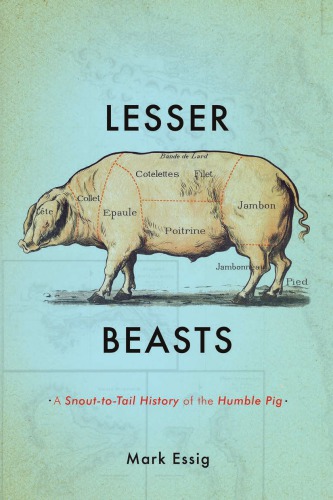
Lesser Beasts
A Snout-to-Tail History of the Humble Pig
کتاب های مرتبط
- اطلاعات
- نقد و بررسی
- دیدگاه کاربران
نقد و بررسی

March 1, 2015
An enlightening culinary history of an "uncanny beast."Essig (Edison and the Electric Chair, 2004, etc.) begins his sprightly tale 65 million years ago, when a giant meteor crashed into the Earth. The climate changed, dinosaurs died, and mammals began to diversify. Ten million years later, the first hoofed animals appeared, pigs among them. Impressively adaptable, they could search out food with a sensitive snout, and they ate everything, ensuring survival in all manner of terrain and climates. Unfortunately, everything included scavenged corpses and human excrement, which led to their being shunned as impure by certain groups: upper-class Egyptians in the fifth century B.C., for example, and Jews. Ancient Greeks and Romans, though, revered pigs, sacrificing them to their gods and feasting on them. Easily preserved, pig meat became a staple of medieval kitchens; lard gave its name to a household's pantry, or larder. Essig makes a convincing case for the importance of the pig in European economies and forays into the New World. Because pigs breed so easily, have a short gestation period, and can successfully forage for food, explorers' ships contained many sows and boars, which could be deposited on land and left to themselves. From a pair or two, scores of pigs were ready as food for future settlers. By the 19th century, Midwestern American farmers discovered a perfect match between the "breathtaking amount of corn" they grew and the pigs they wanted to fatten. Wheat was raised for humans; corn was fed to cattle and hogs. The author engagingly traces the change in meat production as family farms transformed into giant factories, where pigs are packed into crate-sized pens, antibiotics have become routine, and waste from pig farms pollutes water and land. Although the pork industry "claims that confinement barns are perfect for the animals," environmentalists, animal rights groups, and, increasingly, concerned consumers press for change. A lively, informative farm-to-table feast.

April 1, 2015
Essig (Edison & the Electric Chair) presents an entertaining perspective on pigs, especially as they relate to humans. The author begins by detailing the evolution of the creature and how pigs' innate ability to obtain sustenance from a variety of sources and still provide protein for humans has made them crucial to our survival. Taking a mostly chronological view, Essig follows the progress of the pig from Mesopotamia to northern Africa and Europe and eventually the Americas. While countries in Asia are briefly mentioned throughout, this narrative provides a Eurocentric view. Notably, the author covers how pigs were transported across the Atlantic and how they helped New World settlers. Religious views of pigs and changes in attitude toward maintaining and eating the animals are constant themes. Concluding with the problems of contemporary factory farming and case studies of various chain restaurants, this book is very thorough in covering a relevant subject topic. VERDICT After you read this book, pigs will never seem quite the same. Pair it with Ted Genoway's The Chain.--Jason L. Steagall, Gateway Technical Coll., Elkhorn Lib., WI
Copyright 2015 Library Journal, LLC Used with permission.

























دیدگاه کاربران